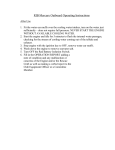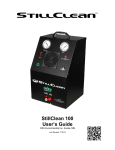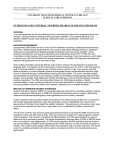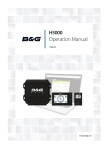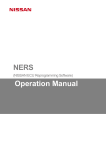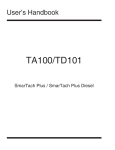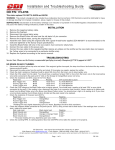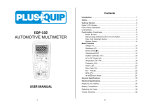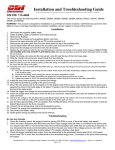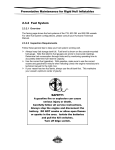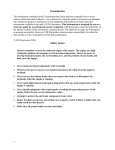Download Installation and Troubleshooting Guide
Transcript
Installation and Troubleshooting Guide All rights reserved. Reproduction or use of content, in any manner, without express written permission by CDI Electronics, Inc., is prohibited. Marine Instrument Cluster VDO Service Manual (Rev 4) January 14, 2008 Model Year 2000 Cluster Functions I/O Cluster Functions: • Speedometer Options: 270° cross-coil movement 80 MPH (270° scale) 60 MPH (270° scale) 50 MPH (270° scale) • Tachometer (6000 RPM) - 270° cross-coil movement • Fuel Level - 90° cross-coil movement, Low Fuel Telltale • Pressure - 90° cross-coil movement, Low Oil Pressure Telltale • Coolant Temperature - 90° cross-coil movement, High Temp. Telltale • Voltage Level - 90° cross-coil movement, Voltage Warning Telltale • Trim - 90° cross-coil movement • Audible Alarm - Continuous tone unit, minimum of 100 dBsp, engine signal warnings and system fault conditions. • Depth Sounder - Single row 4 digit, 7 segment, LC display and telltales for FEET or METERS, shallow water alarm. • Mode and Adj. Button inputs - Select modes and update display • Clock - HH:MM, 7 segment, LCD • Odometer and Trip Odometer - 0.0 to 9999 miles or km, 7 segment, LCD • Engine Hours and Trip Hours - 0.00 to 9999 hours, 7 segment, LCD • Seawater Temperature - 30.0 to 104.0ºF or –1.0 to 40.0ºC, 7 segment, LCD VERY IMPORTANT!! CONNECT THE NEW ADDITIONAL GROUND WIRE FROM THE CLUSTER TO ENGINE GROUND (You will have to run additional wire from the cluster through the boat to the engine) CDI Electronics • 111 Commerce Circle • Madison, AL 35758 • Fax 256-772-5701 • www.cdielectronics.com Installation and Troubleshooting Guide All rights reserved. Reproduction or use of content, in any manner, without express written permission by CDI Electronics, Inc., is prohibited. O/B Cluster Functions: • Speedometer Options: 270° cross-coil movement 80 MPH (270° scale) 60 MPH (270° scale) 60 MPH (220° scale) 50 MPH (270° scale) • Tachometer (7000 RPM) - 270° cross-coil movement • Engine System Monitor - Red warning telltales and audible alarm for: Low oil tank level High engine temperature No oil pressure Check Engine • Fuel Level - 90° cross-coil movement, Low Fuel Telltale • Voltage Level - 90° cross-coil movement, Voltage Warning Telltale • Trim (Optional) - 90° cross-coil movement • Audible Alarm - Continuous tone unit, minimum of 100 db’s, engine signal warnings and system fault conditions. • Depth Sounder - Single row 4 digit, 7 segment, LC display and telltales for FEET or METERS, shallow water alarm. • Mode and Adj. Button inputs - Select modes and update display • Clock - HH:MM, 7 segment, LCD • Odometer and Trip Odometer - 0.0 to 9999 miles or km, 7 segment, LCD • Engine Hours and Trip Hours - 0.00 to 9999 hours, 7 segment, LCD • Seawater Temperature - 30.0 to 104.0ºF or –1.0 to 40.0ºC, 7 segment, LCD CDI Electronics • 111 Commerce Circle • Madison, AL 35758 • Fax 256-772-5701 • www.cdielectronics.com Installation and Troubleshooting Guide All rights reserved. Reproduction or use of content, in any manner, without express written permission by CDI Electronics, Inc., is prohibited. Operator Interface A four character, 7 segment LCD display and two additional dashboard mounted buttons make up the operator interface. The display uses a colon (:) for the clock display and a decimal point (.) to show more accurate values. To show the various information displays, the operator presses the MODE button to advance through the available displays. Dial legends surrounding the LCD display are highlighted by pointer symbols above and below the numeric segments. Depth sounder mode is indicated by lighting the FEET or METERS telltale located to the right of the LCD. TRIP HRS ºF 1 2:3.4 TRIP KM MODE ºC ADJ Buttons SET/Reset Note: A quick start guide showing all functions and settings can be found in the back of this booklet. Main Function Descriptions: V 1.0 Tachometer: 0-6000 RPM I/O, 0-7000 RPM O/B. The Tachometer input is selected at the boat-builder for the number of pulses per engine revolution using VDO calibration software. Pulse ranges are 1-10 per engine revolution. Speedometer: The speed of the boat is measured using the paddle wheel input from the transom mounted traducer (AIRMAR P-32). The speed values can be adjusted up and down by use of the VDO calibration software. See Customer Service Bulletin 99-001 (page 10) and Customer Service Bulletin 6.25.99 (page 11) in the back of this booklet. Fuel Gauge: The fuel level is measured using a standard US Ohm (240-330 Ώ) sensor (Default) or selecting a VDO range 10-180 Ώ sensor using the VDO calibration software. Alarm: A low fuel warning symbol will illuminate when the level reaches 1/6th of a tank or less. Fault: US Range = less than 15 Ώ or more than 280 Ώ. VDO Range = less than 3 Ώ or more than 210 Ώ. In a fault condition, the pointer will return to empty and the horn will “beep” every 2 seconds up to a max of 10 seconds. The telltale will stay on until the problem is resolved. CDI Electronics • 111 Commerce Circle • Madison, AL 35758 • Fax 256-772-5701 • www.cdielectronics.com Installation and Troubleshooting Guide All rights reserved. Reproduction or use of content, in any manner, without express written permission by CDI Electronics, Inc., is prohibited. Coolant Temperature Gauge: The temperature is measured using either a standard US range sensor (Default) or a VDO range sensor can be selected using the VDO calibration software. Alarm: The Temperature telltale will light, the horn will “Beep” for 10 seconds if the engine temperature rises above 213º F. Fault: An Ohm value below 37 Ώ US (27 Ώ VDO) or above 800 Ώ US (500 Ώ VDO) will illuminate the telltale, “Beep” the horn, and move the pointer to the fully “HOT” position. OIL Pressure Gauge: Oil pressure (0-80 PSI) is measured using a standard US 240-33 Ώ US range sensor (Default) or a VDO 10-180 Ώ range sensor can be selected using the VDO calibration software. See Customer Service Bulletin 07-001 (page 15). Alarm: The Oil telltale will light and the horn will “Beep” for 10 seconds if the Oil pressure drops below 6 PSI. Fault: An Ohm value below 15 Ώ US (3 Ώ VDO) or above 280 Ώ US (210 Ώ VDO) will illuminate the telltale, “Beep” the horn every 2 seconds, and move the pointer to the “zero” position. Voltage Gauge: The voltage is measured from the ignition switch input with a scale of 10-16 volts. Alarm: “The Battery” telltale will light and the horn will “Beep” for 10 seconds if the voltage measures below 11 volts or above 16 volts. Fault: The cluster will shut down if the voltage drops below 7 volts or above 16.5 volts in order to protect voltage sensitive components. The Clock and Depth default settings may have to be reset. Trim Gauge: The trim gauge is driven by the OEM engine trim sensors and must be selected using the VDO Calibration Software. The cluster can be programmed for current Honda, OMC, Mercury and Yamaha trim values. Alarm: None Fault: None. Outboard System Monitor (O/B clusters ONLY) The clusters for outboard engine crafts include the outboard engine system monitor. It provides warning telltales and an audible alarm for the Oil Pressure, Engine Temp, Oil Level and Check Engine signals for OMC System Check sensor equipped outboard engine. OIL PRESSURE The telltale shall turn on any time the Oil Pressure warning switch contact closes and the ignition is on. The Telltale shall remain on for a minimum of 30 seconds, and remain on until the fault is corrected and the sensor contact opens or the ignition is turned off. ENGINE TEMPERATURE The telltale shall turn on any time the Engine Temperature warning switch contact closes and the ignition is on. The telltale shall remain on for a minimum of 30 seconds, and remain on until the fault is corrected and the sensor contact opens or the ignition is turned off. CHECK ENGINE The telltale shall turn on any time the Check Engine warning switch contact closes and the ignition is on. The telltale shall remain on for a minimum of 30 seconds, and remain on until the fault is corrected and the sensor CDI Electronics • 111 Commerce Circle • Madison, AL 35758 • Fax 256-772-5701 • www.cdielectronics.com Installation and Troubleshooting Guide All rights reserved. Reproduction or use of content, in any manner, without express written permission by CDI Electronics, Inc., is prohibited. contact opens or the ignition is turned off. OIL LEVEL The telltale shall turn on any time the Oil Level warning switch contact closes and the ignition is on. The telltale shall remain on for a minimum of 30 seconds, and remain on until the fault is corrected and the sensor contact opens or the ignition is turned off. HORN CONTROL This audible alarm control sounds the horn any time one of the four described alert conditions occur while the engine is running above 500 RPM. The horn will sound for 10 seconds and then turn off. SELF-TEST When the ignition is turned on, the outboard monitor system will perform a self-test. The self-test shall consist of a ½ second beep by the audible alarm horn and all four of the warning tell tales shall turn on. At the end of the test, all four of the telltales will turn off in sequence. CLOCK DISPLAY The Clock display is selected by pressing the MODE button. During Clock display, the colon blinks once per second. SETTING CLOCK: To set the time of day, press and hold MODE and ADJUST buttons for 2 seconds while in Clock Display mode. The MODE button is then used to advance through the time set features. Hours are set first, minutes second and the 12/24 hour mode last. The selected digits will blink while being set. While in set mode, ADJUST is used to increment the selected unit of time. Hours are set in the 24 hour format, rolling to zero after 24. Minutes roll to zero after 60. While setting the 12/24 hour mode, 24 is displayed in the hours position and 12 is displayed in the minutes position. The current setting will blink (i.e. 12 will blink if the 12 hour mode is set). MODE and ADJUST are de-bounced for 3/8th’s of a second (You have to press and hold the buttons for over 3/8th’s of a second to change value). If the ADJUST is pressed and held for 2 seconds while setting a numeric value, the key auto repeats at a rate of 6 per second (To scroll through all 60 minutes requires 12 seconds). When the ignition is turned off, the present mode is saved and the LCD displays the time of day. Time setting functions are not available while the ignition switch is turned off. When the ignition switch is turned back on, the LCD display returns to it’s prior display mode. POWER SAVER: The clock keeps time for up to 21 days after the ignition is turned off. During this time, the system is in it’s power saving state. After 21 days, the cluster shuts down to conserve battery power. When the ignition switch is turned back on after 21 days, the clock restarts at midnight in the mode that was active when the ignition switch was turned off. The time must be reset. DEPTH DISPLAY Water depth is measured using an external transducer (AIRMAR “P32 or P19” 200 kHz). It works by measuring the reflected energy of a 200 kHz pulse as it bounces off of the bottom (The transducer depends upon water to act as conductor for the pulsed sound waves). Depth measurement is based upon the speed of sound in fresh water at 68º F (25º C). Small errors can result, depending upon the salinity and temperature of the water. The display indicates depth in feet (1 to 300 foot range) or tenth of meters (0.5 to 100.0 meter range). Accuracy beyond 300’ depends upon bottom conditions, salinity, transom angle, transducer installation and aiming of the transducer. CDI Electronics has no part in the installation of the transducers and cannot warranty the operation of a part over which we have no control. The 300’ operation in salt water is with an AIRMAR P19-U transducer pointed fully down. Performance of the transducer at speed is affected by air bubbles in the water and the ability of the transducer to maintain contact with the wake. CDI Electronics • 111 Commerce Circle • Madison, AL 35758 • Fax 256-772-5701 • www.cdielectronics.com Installation and Troubleshooting Guide All rights reserved. Reproduction or use of content, in any manner, without express written permission by CDI Electronics, Inc., is prohibited. A shallow water depth alarm feature can be set in increments of 1’ (0.3m). The operator sets the valve by pressing and holding the dashboard mounted MODE and ADJUST buttons for 2 seconds. Entering shallow water causes a continuous chirping sound and blinking up/down arrow segments. The shallow water depth alarm setting is displayed as blinking digits. Currant depth is displayed as steady (Not blinking) digits. If the alarm screen is blank, no shallow water alarm is set. If the depth screen shows dashes, the depth is zero or indicates a bad sensor reading. Pressing the MODE button initiates “Set Mode”. The shallow water alarm setting blinks along with the down arrows on the display. Pressing ADJUST sets the alarm toward deeper water. Pressing MODE again indicates the up arrows. With the up arrows on, pressing ADJUST sets the alarm toward shallower water. Pressing and holding ADJUST for longer than 1 second speeds up the process of making the alarm setting deeper or shallower. Pressing the MODE button again allows the depth measurement units to be changed. While in “Units Mode”, the shallow depth alarm setting blinks and the “FEET” or “METERS” telltale flashes. Pressing ADJUST changes between FEET and METERS. Pressing MODE again allows the depth sounder system to be enabled or disabled. In this mode, a blinking message “ON” or “OFF” appears. Pressing ADJUST changes between Sounder On and Sounder Off. In the “OFF” mode, the sounder no longer sends out its periodic sonar ping. The “OFF” mode should be used when using Fish Finders or other equipment that has the same 200 kHz frequency to avoid “Cross-Talk”. Pressing “MODE” again causes a return to normal “Depth Mode”. A time-out feature causes the display to automatically return to depth mode if no button is pressed within 30 seconds. In Depth Display Mode, pressing ADJUST displays the shallow water alarm setting and the alarm blinks for 10 seconds. When shallow water is encountered, the up/down arrows blink and the audible alarm beeps. Pressing ADJUST turns the beeper off, but only for the current low water event. Entering deeper water re-enables the beeper for the next shallow water encounter. ODOMETER (LOG) and TRIP ODOMETER (TRIP LOG) The Log calculates total mileage based on input from the paddlewheel. This value cannot be reset except by the factory or CDI Electronics and is stored in nonvolatile memory. The Trip Log is a distance log that can be reset and will display distance accumulated since last reset. The operator presses both “MODE” and “ADJUST” while in the Trip Log mode to reset to “Zero”. The Log and Trip Log functions will display Statute Miles when the Depth function displays “FEET”. Kilometers will be displayed when the Depth function displays “METERS”. ENGINE HOURS Total engine running hours (above 500 RPM) will be displayed in 1 hour increments. TRIP HOURS This function keeps track of the engine hours with Hour/Minute resolution up to 100 hours maximum. Pressing both “ADJUST” and “MODE” while in Trip Hour mode resets the values to “Zero”. SEAWATER TEMPERATURE This function measures the water temperature at the transducer (AIRMAR P32 or equivalent). When the Depth function is in “FEET”, the function defaults to “º F” (Fahrenheit). When the Depth function is in “METERS”, the temperature defaults to “º C” (Centigrade). CDI Electronics • 111 Commerce Circle • Madison, AL 35758 • Fax 256-772-5701 • www.cdielectronics.com Installation and Troubleshooting Guide All rights reserved. Reproduction or use of content, in any manner, without express written permission by CDI Electronics, Inc., is prohibited. Connector 12 11 10 9 8 7 6 5 4 3 2 1 24 23 22 21 20 19 18 17 16 15 14 13 (Harness Side View) Electrical Pin-out Pin No. 1 Signal Pin No. 13 Depth Transducer Signal In 14 GND (Depth) Depth Shield Bare Wire Black/Purple 3 Depth transducer return Black Blue 2 Signal GND (Signal) 15 Spare (Test/PGM Signal Prototypes only) 16 Seawater Temperature Black/Purple 4 GND (Power) Bare Wire 5 Tan/Black Lighting Input 17 Check Engine Warning Switch (O/B Only) Trim Input 18 Oil Level Switch (O/B Only) 19 MODE Push-Button Dark Blue 6 Purple/White 7 Serial TX Pink/Brown 8 20 Serial RX ADJUST Push-Button Pink/Blue 9 21 Fuel Input Pink 10 Light Blue 11 Speed Sensor (+), 12 V out Purple/Green Oil Pressure Input (I/O) or Oil Pressure Warning Switch (O/B) Tan Engine Temperature Input (I/O) or Engine Temp. Warning Switch (O/B) 12 Tachometer Input Grey 22 Ignition (B+) Purple 23 Battery (+) Red/Blue 24 Speed Input Grey/Pink • The pin connectors are an AMP P/N: 770988-1 • The cluster connector is an AMP Mate-N-Lok P/N: 770587-1 • The extractor tool for removing the pins is an AMP P/N: 455822-2 CDI Electronics • 111 Commerce Circle • Madison, AL 35758 • Fax 256-772-5701 • www.cdielectronics.com Installation and Troubleshooting Guide All rights reserved. Reproduction or use of content, in any manner, without express written permission by CDI Electronics, Inc., is prohibited. FUNCTIONAL DIAGRAM WIRE Depth + Ground Ground Depth Finder Signal In 1 2 Ground DS01 Blue Depth Finder Cable 3 Black/Purple Black/Purple 4 Shield Cluster Lights 5 Blue Trim 6 Purple/White Ground Engine Ground Speedo 0.0Ω to 542Ω Dash Light & Compass 7 N/C Serial TX 8 N/C Serial RX Engine IO 9 Oil Pressure 10 Light Blue Pink Water Temp 11 10 Tan 12 11 Grey 13 12 Black 14 13 Shield Depth Ground 15 14 16 15 240 Ω @ 6 PSI TO 33Ω @ 100 PSI 75 to 857Ω Engine IO Shield Ground 1 Power 2 Engine IO Red Engine IO Signal 1 Green 3 2 Temp No Connection Temp Speedo 4 White Tan/Black 4 17 No Connection 18 No Connection Sea Water US Range 10Ω F to 280Ω Ε VDO Range 3Ω to 210Ω Potentiometer Attenuator Black/Pink Resistor Fuel Sender Fuel Tachometer Ground Set Button 19 18 Pink/Blue Mode Button 20 19 Pink/Brown Speedo 21 20 Purple 22 Purple Ground Set Black Mode 3A Switched 12 V Power Speedo +12 Power Power 23 22 Red/Purple Speeds Signal 24 Grey/Pink 5A 15A +12V +12Volt Power 1 24 2,3,4,13 and 14 are grounded internally CDI Electronics • 111 Commerce Circle • Madison, AL 35758 • Fax 256-772-5701 • www.cdielectronics.com 24 Installation and Troubleshooting Guide All rights reserved. Reproduction or use of content, in any manner, without express written permission by CDI Electronics, Inc., is prohibited. Fault Finding Guide Observed Problem Field Procedure Reference No function with key on -Check for voltage on pins 22 & 23. -Check for ground connection between pin 4 and engine ground. See “Volt Gauge” Erratic function, Pointers flickering and horn chirping If Mercury O/B, check for correct inductive spark plugs necessary on 50, 70, 90 and 120 HP models. Inductive spark plugs are needed due to voltage spikes from the ignition coils. -VDO Bulletin 7.10.99 - Mercury recommended application. Speed & Depth stop working at high speed -Check for transducer position mounting. Transducer is likely too low and cavitating. Transom mount should be nearly flush with bottom. See AIRMAR installation Bulletin. Speedometer not working, Depth OK -Check connections on 24 pin connector. -Check for voltage change from 0 to 8 V while turning paddle one blade at a time. See VDO Bulletin 6.25.99 Alarm horn sounds, Tank light on, Fuel level is OK. -Check tank sending unit for Ohm values. -Check ground on sensor. -Remember an open circuit is a fault. See “Fuel Gauge” Alarm “chirps” with key on while the boat is on the trailer. - The depth transducer will mimic a depth of 0.7 ft while out of the water. Shallow Depth Alarm will sound if a depth alarm value is present. Reset alarm depth to “Zero” See “Depth” Trim Gauge will not go full down or Trim not working properly. -Check OEM trim sender for positioning and range. (May not be installed) -If gauge is erratic as you raise/lower the unit, replace the trim sender. Depth and Clock settings reset to “0” with the key off. Clock not working with the key off. Check for voltage on pin 23 (This should read battery voltage for memory function). Alarm Sounds, Low Oil Warning Light stays on but Oil pressure within range of 7 to 80 PSI. Add a 470Ω ½ watt resister from Light Blue sense wire to engine ground. If this fixes problem, oil sending unit was out of calibration. If not fixed, have cluster repaired Display shows PROG or ADJ when key is turned on and will not change. Disconnect Mode & Adjust switch. If normal display appears, replace switch. If problem still shows, have cluster repaired • An Alarm is a constant tone for 10 seconds, telltale will stay on after tone stops. • A Fault alarm is caused by an “Open” or “Shorted” sender circuit or a sender out of the normal range. The tone is a “Beep every 2 seconds for 10 seconds. • If you cannot determine the root cause of the problem or need a replacement, contact your local service center or email [email protected]. • The cluster connector is an AMP Mate-N-Lok P/N: 770587-1 • The pin connectors are an AMP P/N: 770988-1 • The extractor tool for removing the pins is an AMP P/N: 455822-2 CDI Electronics • 111 Commerce Circle • Madison, AL 35758 • Fax 256-772-5701 • www.cdielectronics.com Installation and Troubleshooting Guide All rights reserved. Reproduction or use of content, in any manner, without express written permission by CDI Electronics, Inc., is prohibited. Customer Service Bulletins Four Winns Dash Panels DATE: 11/11/2003 Bulletin # 99-001 Problem: Speedometer not working, possibly due to wires crossed in the paddle wheel plug. Solution: Determine if the speedometer circuit has crossed wires by checking the wires going into the male plug before doing anything else. Please follow the directions below and refer to the drawing to determine if the wiring is correct. 1. If the wiring is correct, check the module. 2. If the wiring is incorrect, remove the male plug from the female plug. 3. Remove the pins from the male plug using the special AMP removal tool. 4. Check the pins for broken wires and loose connections. Clean as needed. 5. Install the wires in the correct numbered hole. 6. Connect the male and female plugs. (Note: The plugs are directional). 7. Test speedometer. CDI Electronics • 111 Commerce Circle • Madison, AL 35758 • Fax 256-772-5701 • www.cdielectronics.com Installation and Troubleshooting Guide All rights reserved. Reproduction or use of content, in any manner, without express written permission by CDI Electronics, Inc., is prohibited. DATE: 11/11/2003 Bulletin # 6.25.99 Problem: Speedometer not working. Solution: Determine if the speedometer circuit has failed. 1. Connect a DC voltmeter to the “Green” (Signal) and “Bare” (GND) wires of the transducer. 2. With the keyswitch “on”, rotate the paddle wheel one blade at a time. The voltage should switch between “0” and “8” volts as the blades pass by the body of the transducer. 3. If the voltage does not change as the paddle is slowly rotated, replace the transducer. 4. When installing a new transducer, always check it before mounting it. Use jumper wires to power the unit. Transducer Cable Leads Diagram Red, 12 V+ (Positive) Black, 12 V (Ground) Bare, Shield Ground Blue, Depth Signal Transducer Cable Green, Speed Signal White (Optional Temp) Tan (Optional Temp) CDI Electronics • 111 Commerce Circle • Madison, AL 35758 • Fax 256-772-5701 • www.cdielectronics.com Installation and Troubleshooting Guide All rights reserved. Reproduction or use of content, in any manner, without express written permission by CDI Electronics, Inc., is prohibited. Customer Service Bulletins Four Winns Dash Panels DATE: 11/11/2003 Bulletin # 7.10.99 Problem: The 12 V supply from the Mercury 3 and 4 cylinder engines is carrying an unusually high level of RF/EMI noise due to voltage induction from the ignition coils. This RF/EMI noise will cause the LCD clusters to “reset” and “Beep” erratically due to the over-voltage protection built into the LCD cluster. The RF/EMI noise has not been known to damage the LCD clusters. However, the LCD clusters will not operate correctly until the noise is eliminated. Unprotected sensitive electronics, such as transducers and audio equipment, can be damaged by the RF/EMI noise. Solution: Install INDUCTIVE type spark plugs to eliminate the RF/EMI noise. Check the recommended application. Note: Inductive NGK spark plugs have a “Z” in the part number (i.e. BUZHW). Tek Rm: 50ks/s Sample Tek Rm: 50ks/s 0.000 VDC Sample 0.000 VDC A A A-1 100 V 50ms M 5ms ch1 / 32mV Figure 1, Before inductive plugs. 100 V 50ms M 5ms ch1 / 32mV Figure 2, After inductive plugs. CDI Electronics • 111 Commerce Circle • Madison, AL 35758 • Fax 256-772-5701 • www.cdielectronics.com Installation and Troubleshooting Guide All rights reserved. Reproduction or use of content, in any manner, without express written permission by CDI Electronics, Inc., is prohibited. Customer Service Bulletins Four Winns Dash Panels DATE: 11/11/2003 Bulletin # 4.28.99 Problem: Erratic functioning of the Alarm and Alarm Fault circuits. The Marine Cluster uses voltage comparator circuits for gauge functions and to activate various alarms and/or fault functions. This design eliminates the need for separate switches and facilitates the ability to program different parameters. This system requires a good ground path to prevent errors. Solution: Install a separate dedicated ground wire (Minimum 16 gauge) from the Engine block (Or Battery Negative post) to the cluster to ensure proper functioning of the Alarm and Fault Alarm circuits. Be sure to remove the old ground wire connection between the cluster and fuse panel. See diagram below: Ground Circuit Diagram NEW GROUND WIRE, (16-gauge minimum) Cluster -- + Battery Fuse Panel Engine Lights, etc. Fuel Sender CDI Electronics • 111 Commerce Circle • Madison, AL 35758 • Fax 256-772-5701 • www.cdielectronics.com Installation and Troubleshooting Guide All rights reserved. Reproduction or use of content, in any manner, without express written permission by CDI Electronics, Inc., is prohibited. Customer Service Bulletins Four Winns Dash Panels DATE: 11/11/2003 Bulletin # 6.3.99 Problem: Erratic functioning/Reset of the Cluster when the signal horn is used . The Marine Cluster uses voltage comparator circuits for gauge functions and to activate various alarms and/or fault functions. The signal horn may cause a momentary voltage drop when used (Exceeding the Clusters 7 volt working lower limit), causing the Cluster to shut off as a protection for the Cluster’s processor. The Cluster will reset when the horn button is released. However, the depth and clock settings will be reset to default values (“No depth alarm” and “12:00”) and will need to be reset. Solution: Installing a 10uf, 50 V non-polarized Capacitor between the 2 horn wires to eliminate this problem. The Capacitor may be obtained from most electronics stores (Radio Shack’s P/N: 272-999). See diagram below: Horn Circuit Modification Diagram To Switch (White/Orange) + CAP --- Horn To Ground (Black) CDI Electronics • 111 Commerce Circle • Madison, AL 35758 • Fax 256-772-5701 • www.cdielectronics.com Installation and Troubleshooting Guide All rights reserved. Reproduction or use of content, in any manner, without express written permission by CDI Electronics, Inc., is prohibited. Customer Service Bulletins Four Winns Dash Panels DATE: 7/19/2004 Bulletin # 07-001 Problem: Oil Pressure warning horn sounding and oil pressure reading too high or too low in dash meter. Solution: Determine if the oil pressure is actually low by reading the pressure with a mechanical gauge before proceeding. Please follow the directions below. 1. If the oil pressure is above 6 PSI or below 80 PSI, use an ohmmeter to check the resistance on the oil pressure sender (should read less than 240 ohms) from the terminal to engine ground. See the following chart for the approximate values: Oil Pressure 6 10 15 20 30 40 50 60 70 80 90 100 Ohms Reading 234 228 210 191 156 130 112 93 72 57 45 33 2. If you read more than 240 ohms at 6 PSI or less than 33 ohms at 80 PSI, the sender is bad and needs to be replaced. 3. If you read approximately the correct ohms at the different pressures, the sender is working correctly and the wiring needs to be checked. 4. Check the resistance from the light blue wire in the connector (pin # 10) at the dash to engine ground. Refer to the chart above and compare the readings to the ones obtained in step 3. If the readings are close, the dash panel has a fault and needs to be repaired. CDI Electronics • 111 Commerce Circle • Madison, AL 35758 • Fax 256-772-5701 • www.cdielectronics.com Installation and Troubleshooting Guide All rights reserved. Reproduction or use of content, in any manner, without express written permission by CDI Electronics, Inc., is prohibited. Quick Start Front Panel Programming Features For VDO Marine Instrument Module To determine if Module is Front Panel Programmable switch key to “ON”. The module will cycle through a self test and then display the software revision level. This is also indicated on the identification label located next to the harness. 2.3 ProG A 1 b 0 C 0 d 1 E 0 F 1 END Software level 2.0 and greater are capable of being configured for the following functions using the MODE and ADJUST buttons Press MODE and ADJUST buttons and turn on power module. Hold MODE and ADJUST buttons for five seconds unit the display shows “P r o G”, release buttons. Press MODE button to select function and ADJUST to make changes. A= Tachometer: Adjustable from 1-12 pulses per revolution. Press and hold ADJUST button with “up” arrows to increase pulses per revolution. Releasing button displays “down” arrows, press and hold to decrease. Engines: IO 4cyl = 2 pulses, 6cyl = 3 pulses, 8cyl = 4 pulses OB All Mercury, OMC, Johnson, and Evinrude = 6 pulses Yamaha = 6 pulses, except 70 HP and lower = 3 pulses Suzuki = 6 pulses, except 65 HP and lower = 3 pulses Tohatsu/Nisssan = 6 pulses, except 70 HP and lower = 2 pulses Honda = 2 pulses, except on 35 HP - 50 HP = 3 pulses C= Trim: Press and hold ADJUST button with “up” arrows to increase number, releasing button displays “down” arrows, press and hold to decrease. Mercury IO = O Mercury OB = 1 OMC IO = 2 Volvo IO = 3 OMC OB = 4 Evinrude OB = 5 Johnson OB = 6 Honda OB = 7 Yamaha OB = 8 b= Speed: Adjustable from -50% to +50%. Press and hold ADJUST button with “up” arrows to increase pulses per mile (reduce indicated speed). Releasing button displays “down” arrows. Press and hold ADJUST button to reduce pulses per mile (increase indicated speed). D= Fuel, E = Coolant temp, F = Oil pressure U.S. sensor = 1, VDO sensor = 0. Press ADJUST to select Pressing both MODE and ADJUST buttons for 2 seconds will save change. Releasing buttons will exit programming mode and restart module. If no button is pressed for 20 seconds the program will automatically save any changes and exit. CDI Electronics • 111 Commerce Circle • Madison, AL 35758 • Fax 256-772-5701 • www.cdielectronics.com Installation and Troubleshooting Guide All rights reserved. Reproduction or use of content, in any manner, without express written permission by CDI Electronics, Inc., is prohibited. Thank you for using CDI Electronics. 8/30/2007 CDI Electronics • 111 Commerce Circle • Madison, AL 35758 • Fax 256-772-5701 • www.cdielectronics.com



















